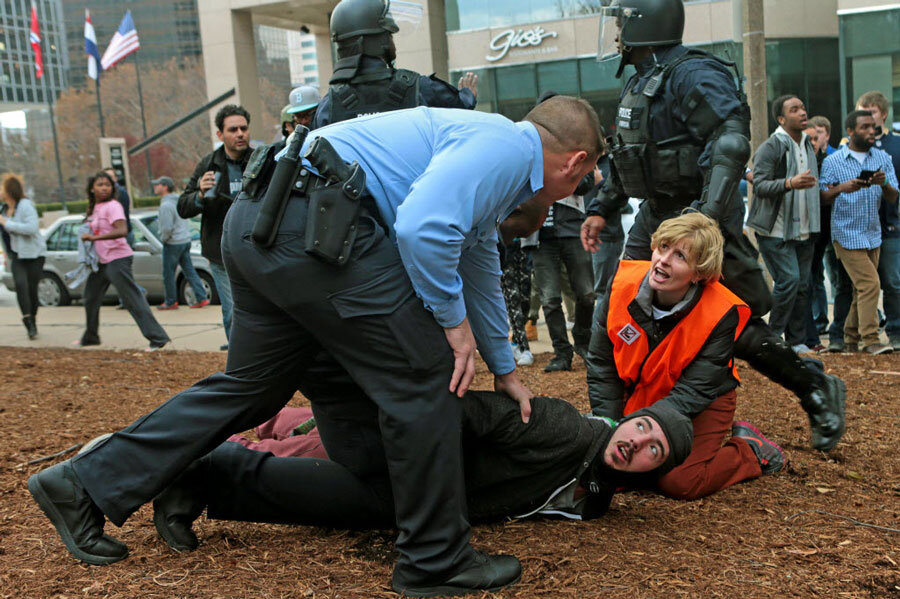With Ferguson plan, Obama seeks to tip balance for police reform
Loading...
President Obama's two major executive actions on police reform, announced Monday, come as police forces nationwide are being pulled between two opposite trends: more empathetic, community policing and an increasingly militarized response to crises.
Mr. Obama's orders are a clear attempt to support more-community-oriented policing. One will fund the purchase of body cameras that have shown promise in reducing use-of-force incidents, and the other will overhaul federal programs that send military hardware to local police departments.
The goal, Obama said, is to change how police officers view the communities they serve. Violent protests last week after a grand jury in Missouri decided not to indict police officer Darren Wilson for killing Michael Brown, an unarmed black teen, highlighted the distrust that exists between police and minorities in many communities, he added.
"This is a problem that is national," Obama said Monday. "It is a solvable problem, but it is one that, unfortunately, spikes after one event and then fades into the background until something else happens. What we need is a sustained conversation ... to move forward in a constructive fashion."
Current efforts to make police culture more entwined with estranged minority neighborhoods date back to the 1990s, when the Clinton presidency made community policing a priority. But the “reform era” of American policing started with court-led changes to police tactics during the 1970s.
Indeed, until a 1985 Supreme Court decision that limited the ability of police to shoot fleeing suspects, "few if any police departments had developed their firearm policy around a value system that reflected reverence for human life," notes a 2003 Justice Department guidebook for police departments called "Principles of Good Policing."
The report challenged police departments to examine their culture. “The key concern is the nature of that culture and whether it reflects a system of beliefs conducive to the nonviolent resolution of conflicts.”
The shift from the strict rule-of-law approach of the past to a more empathetic approach is a dramatic and difficult one, given the life-and-death stakes for police officers on the beat.
“Police officers work in extremely fluid and changing conditions in which the unexpected and unanticipated become the norm,” writes Barry Reynolds, a policing expert, on PoliceOne.com. “The 'business as usual' approach not only enhances that feeling of comfort and stability, it also reinforces a cultural resistance towards change.”
Some presidential decisions in recent decades have only reinforced a fortress mentality and worked against reform, analysts say. Presidents Nixon and Reagan expanded the “War on Drugs,” which opened the door to reliance on militarized police tactics against nonviolent suspects.
“The problem has little to do with the Constitution, and solving it doesn’t require some radical innovation in police practice,” as Peter Moskos, author of “Cop in the Hood” and a criminal justice professor at the John Jay College of Criminal Justice, wrote recently. “The relevant question is political: Having given our police broad access to military weapons and tactics, will we ever choose to take them away?”
The potential of Obama doing just that points to the difficulties his gambit is expected to face. For one thing, police enjoy solid public support. Some 53 percent of Americans put "quite a lot" of confidence in the police as an institution, putting cops next to soldiers and small business owners at the top of the confidence charts, according to a June Gallup poll.
But the technological aspect of Obama's executive orders gives his efforts a distinct flavor. Specifically, body camera technology empowers African-Americans, who historically haven’t had much of a say about the limits of police power.
“Communities of color were largely powerless during [the early days of policing] … and during the reform era police strategy was determined largely on the basis of law, although communities of color were largely unprotected,” according to the Justice Department report. “In today’s community era of policing, one of the tenets is the requirement for a cohesive community working in partnership with a responsive police department. [Research shows] that this precondition does not prevail in many minority neighborhoods.”






